Wildfires in Abai region: national tragedy, lessons not learnt

Wildfires in the Abai region
Fires broke out on June 8 in the Batpayevskiy forestry of the Semei Ormany (forest in Kazakh) state natural reserve in Abai region, eastern Kazakhstan. The forestry is located 25 kilometers away from the town of Semey.
Deputy governor of Abai region Dimitry Garikov said two lighting charges caused the fire.
Because of high temperatures and strong winds, fires rapidly spread, covering an area of 60,000 hectares, close to the area of big cities like Astana and Almaty. He noted the fire was not curbed right away because the firefighting equipment was hard to move over the terrain. As the fire escalated further, some residents had to be evacuated on the night of June 12.
The fire is still burning, as evident from the NASA Worldview, interactive interface for browsing full-resolution, global, and daily satellite images.
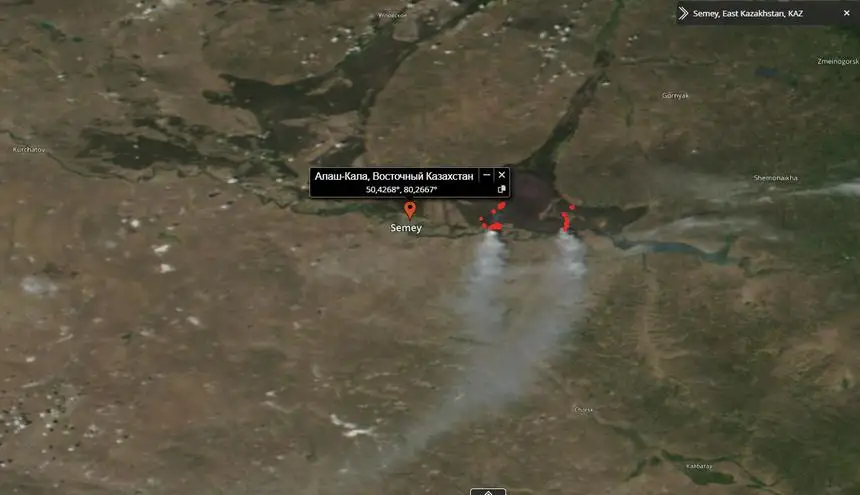
According to the Kazakh Ministry of Emergency Situations, there is no threat to the settlements.
At present, nearly 1,800 personnel and more than 350 vehicles of the Ministry of Emergency Situations, the Ministry of Ecology and Natural Resources, local executive bodies and the Ministry of Defense are involved in the firefighting effort.
Helicopters continue to make an aerial survey of the fire front and water dropping on the fire. Over the past day, 535 water dumps with a volume of about 1,600 tons were carried out. Since the beginning of the fire, a total of 1,858 water discharges with a volume of more than 5,400 tons were made.
President Kassym-Jomart Tokayev flew to Abai region on June 11 to assess the efforts to fight the fire and the scale of the damage. He met with people who lost their family members in the fire, promising comprehensive support and expressing condolences and apologies for the failure to prevent the fire from spreading further.
 Photo: t.me/aqorda_resmi
Photo: t.me/aqorda_resmi
At the June 13 government meeting, Prime Minister Alikhan Smailov instructed to find out all the circumstances of the accident and draw a conclusion within 10 days.
He also said the families of the victims would be paid 7 million tenge from the Qazaqstan Halqyna Fund a public fund to address acute social issues, created at the initiative of President Tokayev. Two million tenge will be paid for each minor child. At the same time, a separate fund was established to provide support measures to the families of the victims.
Citizens from all over the country are also sending humanitarian aid to support the families affected by the fire. Meanwhile, more than 40 universities in Kazakhstan are ready to provide grants and places in dormitories for students from families affected by the fire.
Forest lands in Kazakhstan
Kazakhstan, the ninth-largest country in the world, has diverse geographical features, including vast steppe regions, mountain ranges, and forested areas. While the country does have forests, they cover a relatively small portion of its landmass of 11 percent. Forests are primarily found in the northern and northeastern parts of Kazakhstan.
According to the Forestry and Wildlife Committee, as of 2022, the total area of the state forest fund was 30.5 million hectares, occupying 11.2 percent of the country’s territory. Forest area occupies 13.6 million hectares or 44.6 percent of the total area of the forest fund. The forest cover of the nation is 5 percent, which is considered low globally.
 Photo credit: Kazakh Ministry of Emergency Situations
Photo credit: Kazakh Ministry of Emergency Situations
74.9 percent is under the jurisdiction of regional akimats (city and regional administration), and 24.4 percent, or 7.4 million, is under jurisdiction of the committee, including Semey ormany, which comprises 35 forestries.
Kazakhstan is vulnerable to forest fires
According to the Global Forest Watch (GFW), an initiative led by the World Resources Institute (WRI), a global research organization, designed to provide real-time monitoring and analysis of global forest resources and changes, the peak fire season in Kazakhstan typically begins in late March and lasts around 28 weeks. The GFW combines satellite technology, open data, and crowdsourcing to offer a comprehensive and up-to-date understanding of the world's forests.
The GFW indicates there were 5,567 fire alerts reported between June 6, 2022, and June 5, 2023, considering high confidence alerts only, which refer to those with greater than 80 percent confidence that the alerts are not false positive. The institute notes it is normal compared to previous years going back to 2012. Since the beginning of 2023, 3,013 fire alerts have been recorded.

How many fires occurred in recent years?
According to the Kazakh Emergency Ministry, in 2022 alone, 800 forest fires and 111 steppe fires were registered in the country. In 2021, there were 749 forest fires and 701 forest fires in 2020.
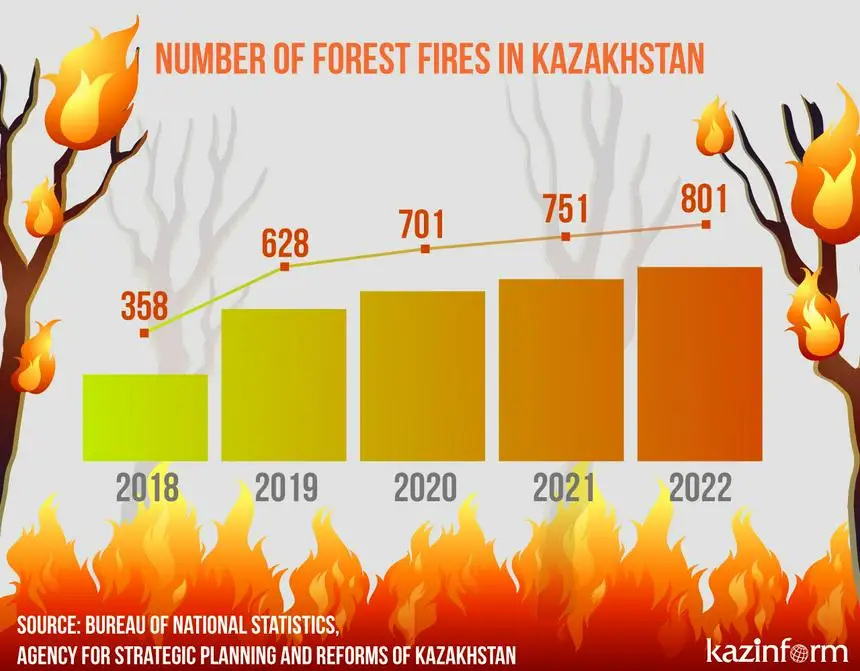
According to the Bureau of National Statistics, the number of forest fires in the last five years has increased by 2.2 times.
However, there is a significant disparity between the number of fires reported by Kazakhstan’s authorities and the data provided by the GFW. This discrepancy can be attributed to differences in methodology for accounting and tracking fires. For instance, in the previous year, the official records from the state forest fund indicated only 801 fires reported, resulting in a staggering loss of 103,000 hectares of forest area.
Since the beginning of the year, Kazakhstan has registered 122 forest fires. The total area of fires amounted to more than 19,000 hectares, and the damage caused exceeded 51 million tenge, data from the Kazakh government shows.
 Photo credit: Kazakh Ministry of Emergency Situations
Photo credit: Kazakh Ministry of Emergency Situations
One of the most devastating fires hit the Amankaragai district in northern Kazakhstan in September 2022. Yet, the lessons from the tragedy have not been learnt.
«Last year's natural fires showed the severity of possible negative consequences due to violations of fire safety requirements. (...) A tragic example was a major fire in Kostanai region, which occurred in September last year on the territory of Basaman and Semiozernyi forestry. As a result, one person was killed and 91 houses were destroyed by fire. Damage from the fire amounted to more than 18 billion tenge, the area covered by the fire was more than 39,000 hectares,» said First Vice-Minister for Emergency Situations Ibrahim Kulshimbaev at a government meeting on May 16.
Ministry of Ecology and Natural Resources Zulfiya Suleimenova said of the 801 forest fires in 2022, 444, or 55 percent forest fires occurred due to lightning discharges, 127 cases, or 15 percent, arose from the transition of steppe fires on forest areas, 208 cases, or 26 percent occurred for unspecified reasons.
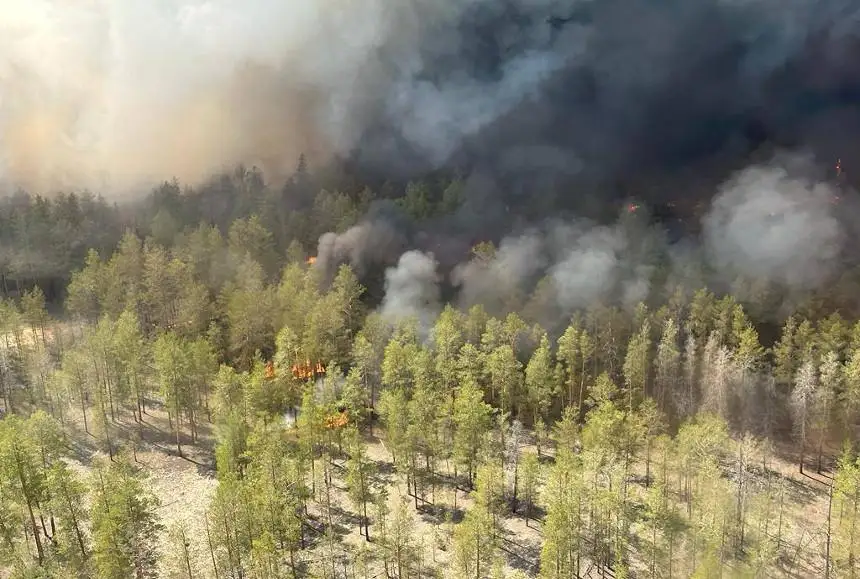 Photo: t.me/abai_oblysynyn_akimdigi
Photo: t.me/abai_oblysynyn_akimdigi
According to the data from the Kazakh government, overall, about 40 percent of fires are caused by natural phenomena, and more than 50 percent are the result of human activity.
Corruption's grip
One of the factors contributing to the severity of the fires in Abai region is the rampant corruption within the forestry sector. A lack of transparency and accountability has allowed unscrupulous individuals to exploit their positions for personal gain, compromising the effectiveness of fire prevention and response efforts, and bribes have become distressingly common, undermining the region's ability to protect and manage its forests.
According to Didar Smagulov, a public council member at the Anti-Corruption Agency, the problem did not happen overnight - it is the reflection of years-long systemic problems. The data provided by him indicates that Semey Ormany had more than 5.3 billion tenge allocated for state procurement. Yet, many of forestry workers that were killed in the fire did not have the necessary equipment.
Within the comprehensive plan of priority measures in civil protection for 2023-2027, in 2023, 8.2 billion tenge has been allocated for material and technical support of environmental protection agencies, and 4.1 billion tenge to introduce an early fire detection system.
 Photo: gov.kz
Photo: gov.kz
»The Emergency Ministry receives billions of tenge every year, but where is this money. Why are they not used for their intended purpose, where do they go, why do people have no uniforms, no masks, radios, batteries go dead, as the President was told. (…) Today in the age of technology, Kazakhstan has three satellites. Kazakhstan can use geoinformation systems, so-called GIS systems, we can also use remote sensing and the question arises why is it all underused,» said ecologist and expert of the Public Chamber of the Majilis Aizhan Skakova in an interview with Kazinform.
Poor equipment
The inadequate equipment and resources available to forestry workers exacerbate the challenges they face. Outdated tools and insufficient fire suppression equipment have left brave individuals ill-prepared to combat the fires.
Despite the measures taken, forestry sites in the regions are not equipped enough in case of fire. Due to wear and tear, 52 percent of the available equipment is not ready for liquidation of natural fires, according to the Kazakh government.
 Photo: gov.kz
Photo: gov.kz
In some regions, the equipment of environmental and forestry agencies does not exceed 50 percent.
«We have all the equipment, frankly, outdated. The logistical support is very weak. There are a few machines from 2014, and the rest are from the 1970s, 80s and 90s,» said Murat Karimov, acting director of the Semey Ormany reserve.
According to him, the reserve employs nearly 1,500 people. However, there is not always enough equipment for such a number of employees, Karimov emphasized.
»According to the norms, it is enough, but when several fires occur in one day, there isn't enough equipment. Because the forest area is hard to reach for transport, ordinary cars can't pass. Even Kamaz and Ural trucks sometimes cannot get through. When this fire started, 4-5 cars didn't reach the place,» he said.
 Photo: t.me/EcologyofQazaqstan
Photo: t.me/EcologyofQazaqstan
Aizhan Skakova noted that the Semey Ormany reserve was quite well equipped, yet none of that equipment worked when needed.
«A multi-level fire watch system has been implemented. There are forest patrol cars that can go to any terrain. There are video cameras and sensors that pick up smoke at a distance of 15 kilometers. But nothing was actually working when this fire happened. The patrol car was supposedly stuck in the sands. How was it possible that the people were left face to face with the disaster, without uniforms, literally fighting the fire with their bare hands? As a deputy of the Majilis of Parliament, we sent a request for the need to purchase special robotic equipment on a tracked basis, so that it could be launched into the hearth and not risk people,«said Skakova.
Poor inter-agency work
Skakova believes inter-agency coordination in preventing and fighting the fires is very weak
«In general, regarding the response [to fires], local executive bodies are responsible for ensuring the protection of the forest, the protection of the territory. It is clear that the Ministry of Emergency Situations puts out fires and reacts, the Ministry of Emergency Situations is in every region, they have their own functions. The Ministry of Ecology also has a forestry committee and the Ministry of Ecology is responsible for all the actions, policies, and methods of work. What has happened shows that the inter-agency coordination is very weak. I think that after this there will be appropriate lessons learned,» she said.
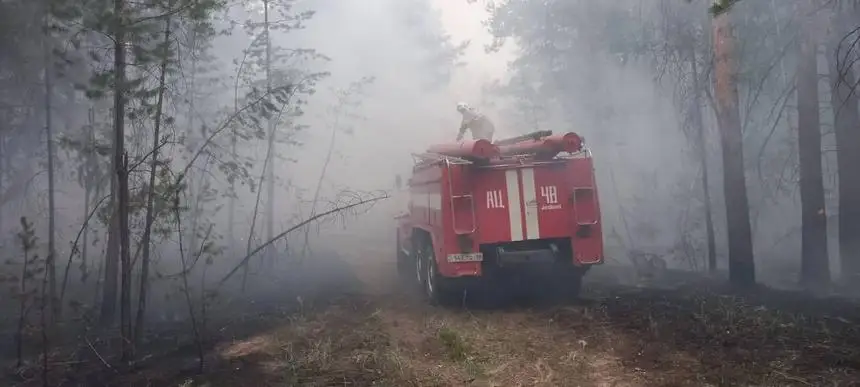 Photo credit: Kazakh Ministry of Emergency Situations
Photo credit: Kazakh Ministry of Emergency Situations
Damage incurred by wildfires in Abai yet to be determined
A special commission has yet to determine the exact amount of damage caused by the fire. However, according to experts, the damage is very serious.
Skakova said it would take 20-30 years to restore the trees, not to mention the funds needed for this. Considering the whole ecosystem, it will take 70 years to restore it.
»The territory of Kazakhstan is not the most forested, and forests are of high value to us. The saddest thing is that recently we have been losing a lot of forest areas. In this case, the ecosystem has suffered irreparable damage, and ribbon-like relic pine forests have been lost. Their specificity is that they grow on sandy soil, saline soil, that is why their restoration requires a lot of investment, effort and time. At least 70 years,«explained Skakova.
Wildfires expected to soar
International organizations predict wildfires will grow, while governments are not well-prepared. For example, according to a February 2022 report by the United Nations Environment Programme (UNEP) and GRID-Arendal, the combination of climate change and land-use change is expected to lead to a higher frequency and greater intensity of wildfires worldwide. The report projects a potential global increase in extreme fires of up to 14 percent by 2030, 30 percent by the end of 2050, and 50 percent by the end of the century. This highlights the growing concern surrounding the impact of these changes on wildfire occurrences.
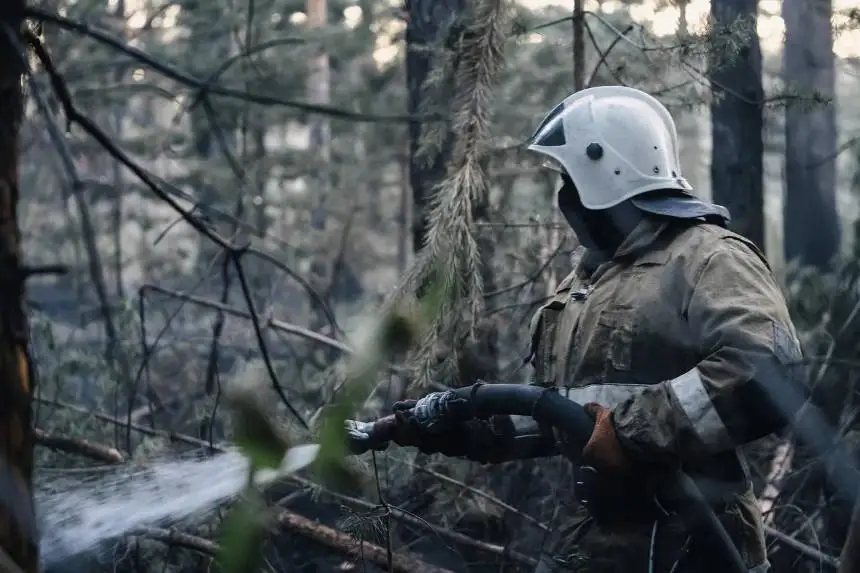 Photo credit: Kazakh Ministry of Ecology and Natural Resources
Photo credit: Kazakh Ministry of Ecology and Natural Resources
«Wildfires and climate change are mutually exacerbating. Wildfires are made worse by climate change through increased drought, high air temperatures, low relative humidity, lightning, and strong winds resulting in hotter, drier, and longer fire seasons. At the same time, climate change is made worse by wildfires, mostly by ravaging sensitive and carbon-rich ecosystems like peatlands and rainforests. This turns landscapes into tinderboxes, making it harder to halt rising temperatures,» reads the report.
Notably, the UN Economic and Social Commission for Asia and the Pacific projects an annual average temperature increase of 2.2 - 2.7 Celsius degrees by mid-century compared to the reference period of 1986-2005.
According to the Sixth Assessment Report of the UN Intergovernmental Panel on Climate Change, the average annual temperature will increase by 1‑2 degrees Celsius by 2030 and 2‑3 degrees Celsius by 2050. It is projected that by 2050, precipitation levels will increase by up to 10%, primarily during the winter season. However, the southwestern regions of Kazakhstan are expected to receive comparatively lower precipitation levels than the rest of the country.
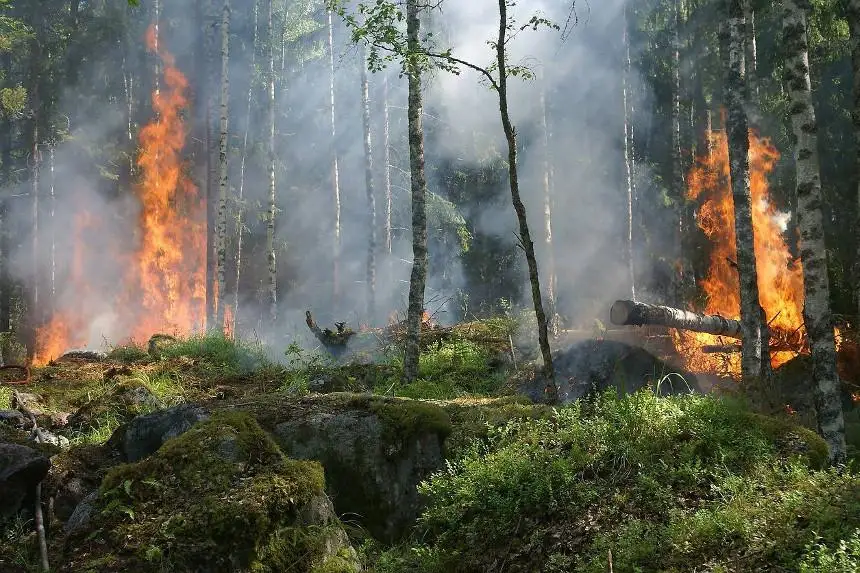 Photo credit: Kazakh Ministry of Emergency Situations
Photo credit: Kazakh Ministry of Emergency Situations
A call for change
In the aftermath of the tragic loss of life and the destruction wrought by the fires in Abai region, there is a growing urgency for comprehensive reform within the forestry sector. Kazakhstan’s citizens, environmental activists, and concerned individuals are demanding transparency, accountability, and investment in modernizing the infrastructure and equipment available to forestry workers.
Addressing the challenges plaguing the forestry sector requires a multifaceted approach. This includes strengthening anti-corruption measures, enhancing the capacity and training of forestry workers, and establishing clear lines of jurisdiction and cooperation between relevant ministries and agencies. Additionally, engaging local communities in forest management can create a more sustainable and resilient approach to fire prevention and response.
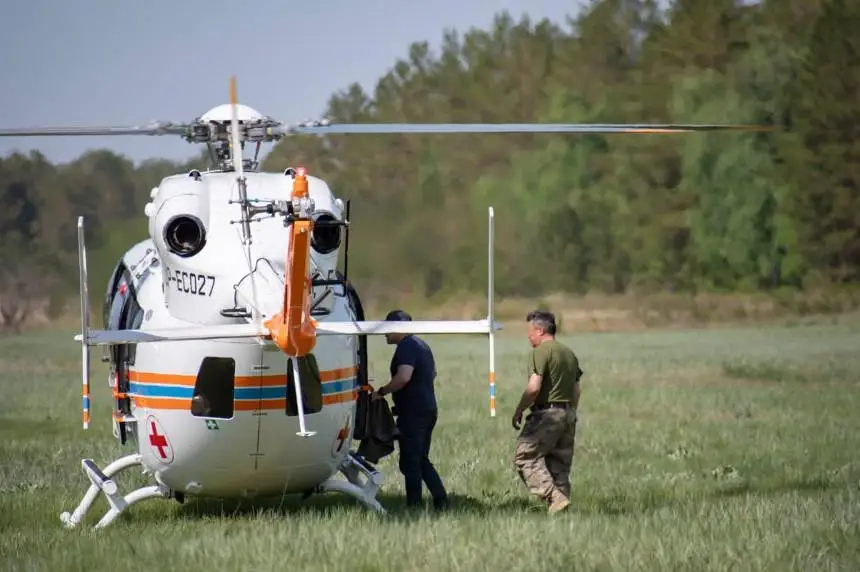 Photo: t.me/EcologyofQazaqstan
Photo: t.me/EcologyofQazaqstan
Kazakh environmentalist Mels Yeleusizov notes the importance of working with the population.
»It is necessary to carry out active awareness raising work. After all, in most cases, tragedy can be avoided by following instructions on how to handle fire in the forest, or extinguish the fire in its very beginning. If a fire does break out, don't stay on the sidelines, but try to localize and put it out. At one time, I suggested organizing volunteer teams to inspect forests in dangerous periods. After all, this concerns the lives of all people and the country's environment,«said Yeleusizov in an interview with Kazinform.
The fires that have ravaged Abai region in eastern Kazakhstan serve as a tragic reminder of the deep-rooted problems within the forestry sector. Only by acknowledging these systemic issues and taking bold steps to ensure forests are protected, forestry workers are decently paid, and transparency is ensured in how the funds are used, can we hope for sustainable forest management and protecting the lives and livelihoods of those who call Kazakhstan home.
 Photo credit: press service of the Abai region akimat
Photo credit: press service of the Abai region akimat